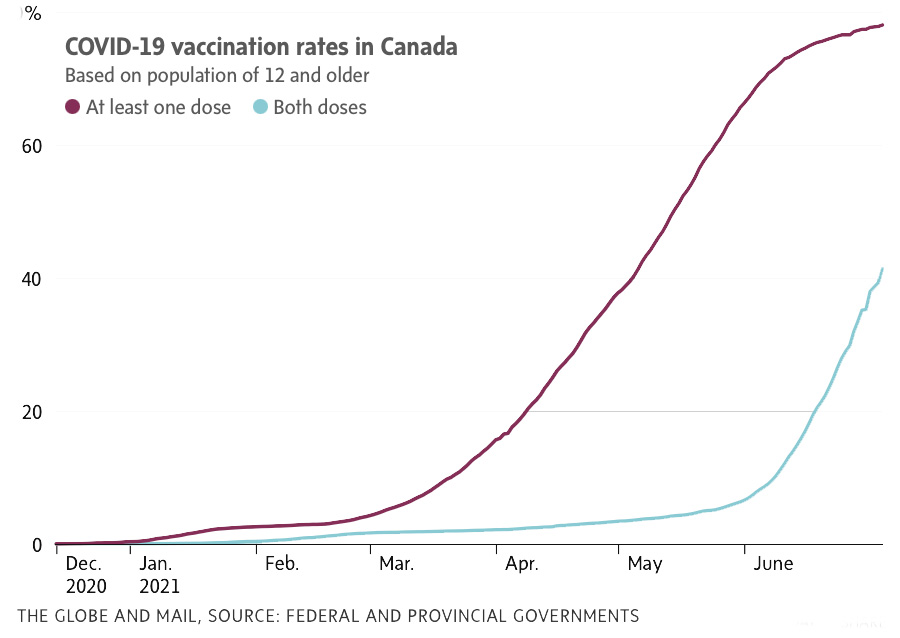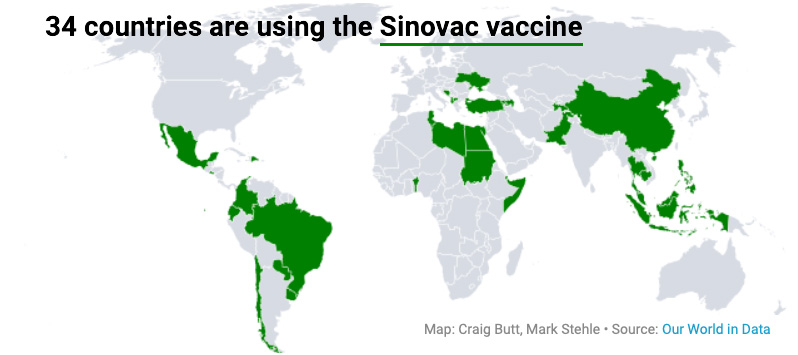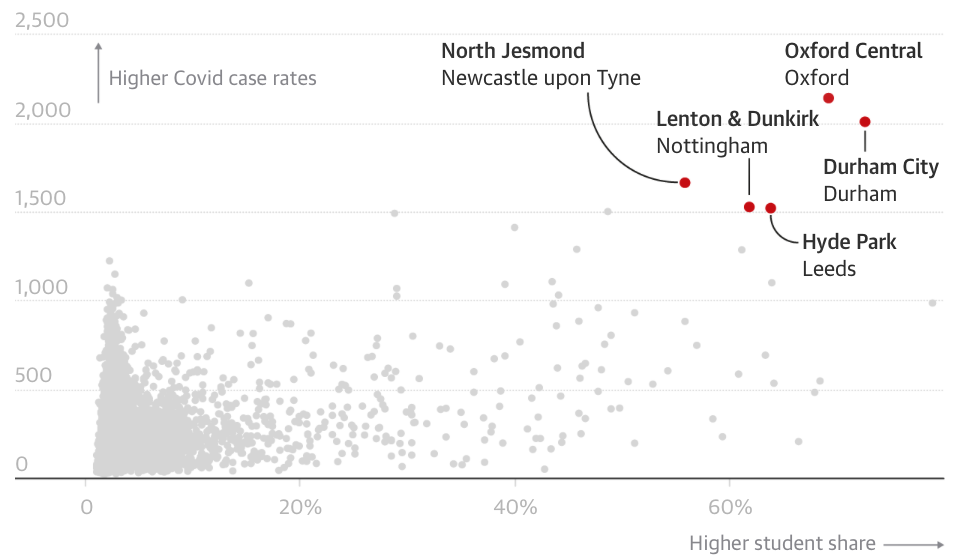Eduvation Blog
Tuesday, July 13, 2021 | Category: Eduvation Insider
Vaccines & Variants
Good morning, and happy “Embrace Your Geekness” Day. (If you want to get into the spirit, check out the Geek anthem below, ICYMI.)
Yesterday’s “Pandemic Précis” ran overlong, so I didn’t have room to dig into more details about vaccines and their effectiveness against the variants. That, and the willingness of young people to get vaccinated, will likely determine the kind of Fall we see for CdnPSE…
COVID on Campus
In the 2 weeks since Jun 28, I have noted just 3 cases of COVID19 reported by CdnPSEs…
uWaterloo reported 3 cases of COVID19 on its campus, on Jul 7, Jul 8, and Jul 12. All are in self-isolation, and only the third had identified close contacts on campus.
Whether reporting has waned or we’re simply looking at more empty campuses for the summer months, I think I can stop monitoring campus case counts until fall. See my master spreadsheet for the tally of 2,772 cases in CdnPSE since Sept 2020.
Vaccine Plateau
While Canada generally has less vaccine hesitancy than our neighbours to the south, provincial and federal PHOs are nonetheless concerned that vaccine uptake is slowing here too…
Few Breakthrough Infections
The US CDC reports that just 0.01% of 101M fully-vaccinated Americans were infected with COVID19 between Jan-Apr 2021. In all, 10,262 infections were documented 14+ days after the final dose of Pfizer, Moderna, or J&J vaccines. 64% were caused by COVID19 variants of concern. 63% of patients were females, and their median age was 58. 27% of cases were asymptomatic, 7% were hospitalized, and 1% died. The CDC suspects many asymptomatic breakthrough cases were simply not reported or tested – and decided on May 1 to stop monitoring breakthrough infections except for severe cases. CTV
Canadian Complacency?
Overall, the country reached 78/41 (first/second dose vaccinations) for eligible Canadians last week, putting us second only to Britain in the G7. But there are regions with 20% or less at even a single dose, such as High Level AB, or Stanley MB. And although second-dose counts are climbing, first-doses have plateaued since Jun 20, despite expanded eligibility and increased vaccine supplies. Some epidemiologists warn that we need to achieve 80-90% full vaccination to avoid another pandemic wave this fall. To close that gap will require interventions to overcome barriers to access vaccines, such as pop-up clinics in targeted neighbourhoods. Information campaigns also have to target those who are vaccine-hesitant (~12-14% in SK), if not the full-fledged anti-vaxxers (~10%). For some, provincial lotteries serve only to increase distrust of vaccines. Globe & Mail
Vaccine Problems
For months, the news has been filled with reports of issues with efficacy and side effects of various COVID19 vaccines, resulting in misinformation and vaccine hesitancy among a general public unused to assessing probability and risk. (The bad press has particularly afflicted the Oxford/Astra-Zeneca vaccine – see “AstraZeneca’s Unforced Errors” for a recap.) Of course, concerns have continued to arise, and in the face of more virulent variants, variations between vaccines are starting to matter more…
Sinovac Half-Works
China’s Sinovac sold some 395M doses worldwide of its COVID19 vaccine (mostly to poorer countries like Indonesia, Brazil, Chile, Turkey and the Philippines), based on initial claims of 78% efficacy. That was far lower than the 95% claimed by mRNA vaccines (Pfizer and Moderna), but Sinovac could be stored easily and was priced affordably. But in January, a Brazilian clinical trial with healthcare workers found Sinovac was just 50.4% effective at preventing symptomatic COVID19, although it was 100% effective against severe or even moderate disease. (China’s foreign ministry is blaming Western media for trying to discredit Chinese vaccines.) Vice
Governments using the Sinopharm vaccine “have to assume a significant failure rate and have to plan accordingly. You have to alert the public that you will still have a decent chance of getting infected.” – John Moore, Cornell University
Vaccines are Not All Equal
China bypassed the final stage of clinical trials to rush its Sinovac and Sinopharm vaccines to market, and data since has been sparse. In Brazil, Sinovac seemed to cut symptomatic COVID19 in half, but protection was 67% in Chile and 85% in Turkey. A virologist who consults for WHO suspects both vaccines are about 50% effective. China itself is relying on the vaccines to protect its own 1.4B people. 4 countries that secured large supplies of Sinovac and Sinopharm – Chile, Mongolia, Bahrain and the Seychelles – were battling major outbreaks last month. In Mongolia, both caseloads and deaths are spiking. Chile’s hospitals are overwhelmed. Ten fully-vaccinated doctors died of COVID19 in Indonesia, where death rates are escalating. Australia and many other countries are not recognizing Sinovac or Sinopharm as approved vaccines. (The US is still not recognizing AstraZeneca, either.) Sydney Morning Herald
As COVID19 vaccines are rolled out to the world at unprecedented scale and speed, extremely rare side effects are being uncovered that unfortunately only serve to increase vaccine hesitancy and conspiracy theories…
J&J and Guillain-Barré
Yesterday, we learned that Johnson & Johnson’s single-dose COVID19 vaccine will get a new FDA warning after it has been associated with ~100 cases of Guillain-Barré syndrome, a very rare neurological condition that can lead to nerve damage, paralysis or even death. Fully 95% of those cases required hospitalization, and most involved men over 50, the population typically most at risk of GBS. So far, only ~12.8M Americans have received the J&J vaccine, because of production delays and regulatory violations at a Baltimore factory. New York Times
Understanding Blood Clots
In an article published last week by Nature, McMaster U researchers have clarified the way in which adenovirus vector COVID19 vaccines (like AZ and J&J) trigger the rare but sometimes fatal Vaccine-Induced Thrombotic Thrombocytopenia (VITT). In about 1 in 60,000 people, these vaccines trigger the formation of unusual antibodies to blood platelets, leading to “a self-perpetuating vicious cycle of clotting events.” The next step is for researchers to develop a more reliable, rapid test to diagnose VITT. McMaster
mRNA Haves and Have-Nots
The global race to develop COVID19 vaccines included “safe bets” like protein-based vaccines based on time-tested technology, which have moved too slowly to matter. The “medium bets” (AZ and J&J) were based on adenovirus vector technology which had been tested before, but never deployed at scale. The “long shots” (Pfizer and Moderna) were based on new and unproven messenger RNA (mRNA) technology. As you know by now, the supposedly “safer” bets have proven to have drawbacks, from lower efficacy to fatal blood clot risks. The “long shots,” on the other hand, “have proved astonishingly effective and extremely safe.” The problem, however, is that their high price, limited supply, and distribution challenges may make them “functionally unavailable to much of the world.” The Atlantic
Invincible Youth
For decades, public health initiatives from anti-smoking to drunk-driving campaigns have found it particularly challenging to shift the behaviours of young people, who often feel invincible and resist any (apparently) arbitrary directives from authority figures. The challenge has been compounded during the pandemic, when messaging has made it clear throughout that young people are far less susceptible to serious illness or death from COVID19, and vaccination campaigns have focused on the oldest and more infirm in our communities first. The problem now is that those youth – our students! – constitute the biggest population of at-risk people…
$300,000 Street Party
I reported last week that Kingston Police broke up a 300-person party Jul 3-4 on Aberdeen Street, in the university district near Queen’s, and that charges were likely pending (since the Reopening Ontario Act sets a cap of 25 people). Sure enough, last Wednesday police announced charges against 3 Queen’s U students, roommates who were presumed to have acted as “hosts” for the gathering on their premises. (Legislation assumes guilt unless the tenant calls police to lay trespassing charges.) If convicted in October, each student could face fines of $10,000-$100,000, and even imprisonment for up to 12 months. (Queen’s will determine whether to apply the student code of conduct as well.) Police are continuing to investigate tenants of other properties who might also have acted as “hosts.” Kingstonist
4.5M Unvaccinated
Theresa Tam, Canada’s chief PHO, is concerned that 4.5M younger Canadians haven’t yet received even a single dose of COVID19 vaccine, even though they tend to socialize more, and can infect other more vulnerable people (including some who are fully immunized). CTV
Gen Z isn’t Waiting
An NBC/LX poll of 2,200 US adults in March found that Gen Z and Millennials 18-34 were most likely to say they either will not get vaccinated (23%) or don’t know (21%). Gen Z (the 18-23 year olds) were even more disinterested, and “spring break crowds may be an indication Gen Z isn’t waiting for a vaccination.” Strikingly, the vaccine hesitancy among American youth is up substantially from a year ago, when only 5% of Gen Z said they would not get a shot. (And it’s not defined by partisan politics, since younger adults tend to lean Democrat, and 80% of Biden voters plan to get vaxxed.) Counter-intuitively, the poll also found that men were more likely than women to say they had been or planned to be vaccinated (71% vs 55%). NBC LX
Student Hotspots in UK
The Delta variant now surging in England has evolved to prey on the partially-vaxxed, and since those aged 18-20 only became eligible for first doses on Jun 17, they remain most vulnerable. England’s 5 current COVID19 hotspots are neighbourhoods with particularly dense student populations, including regions of Durham (73% students), Oxford (69% students), Leeds (64%), Nottingham (62%), and Newcastle (56%). To make matters worse, many quarantining students were evicted by their landlords Jul 1, when student tenancies typically end. The Guardian
Passport as Incentive
I mentioned yesterday that Quebec is struggling to get young people in the province vaccinated: just 2% of 12-17-year-olds, and 16% of 18-29-year-olds, are fully vaccinated. With 19% of the Quebec population under age 17, many experts believe herd immunity is unreachable without inoculating minors. Since Quebec proposed a vaccine passport to limit access to bars and nightclubs during regional outbreaks, the rate of vaccination among those aged 18-29 has started to improve, particularly in Montreal. “We are not ruling out any strategy to encourage young adults to get vaccinated,” including a potential lottery program. Montreal Gazette
Vaccines & Variants
Since the beginning of the COVID19 pandemic, researchers have been on alert for the rise of new variants of concern which could be more transmissible and even more resistant to existing vaccines. The Alpha (UK) variant proved 50% more transmissible, but was brought until control by Britain’s AstraZeneca vaccine (as well as the more effective mRNA vaccines from Pfizer and Moderna). In South Africa, though, the Beta variant proved too resistant to the AZ vaccine, prompting the government to return doses it had already purchased. The world has been holding its breath waiting for more solid research results on vaccine effectiveness against the variants…
Moderna and the Variants
In late June, Moderna announced lab test results that showed its vaccine had a “modest” decrease of 2-3-fold in producing neutralizing antibodies against the Delta and Kappa variants of COVID19. On the other hand, Moderna’s vaccine produced 6-8-fold fewer antibodies against the Beta variant (South Africa). CTV
Pfizer and the Variants
In a pre-publication study, the Israeli Ministry of Health reports that as the Delta variant rose to dominance in the country, vaccine effectiveness dropped to 64% against infection or symptomatic illness, although it remained highly effective against severe illness or hospitalization (down from 98% to 93%). Anthony Fauci, chief medical advisor to US president Joe Biden, urges caution in interpreting the results: “I’m not so sure we can make any major conclusions based on the information we have right now.” Public Health England reported in May that the Pfizer vaccine was 88% effective against symptomatic COVID19, while the Delta variant was spreading in that country. A Scottish study published in The Lancet last month found that the Pfizer vaccine provided 79% protection against infection from the Delta variant (compared to 92% against the Alpha/UK strain). By comparison, Astra-Zeneca’s vaccine offered 60% protection against infection from Delta, and 73% against Alpha. CTV
Efficacy in Canada
The Canadian Immunization Research Network released preliminary research last week, based on data from 420,000 Ontarians, that suggests all 3 vaccines being used remain very effective against the big 4 variants of concern. After 2 doses, Pfizer provided 89% protection against symptomatic infection from Alpha, 84% against Beta and Gamma, and 87% against Delta. Moderna provided 92% against Alpha, and appeared more effective than Pfizer against the other variants (based on first-dose results). AstraZeneca appears less effective than the mRNA vaccines against Beta and Gamma in particular (again based on first-dose results). The Gamma variant (P.1 from Brazil) appeared to show the greatest ability to evade the vaccines, although the authors concede that sample sizes for Delta are less reliable. “Even a single dose of these 3 vaccine products provides good to excellent protection against symptomatic infection and severe outcomes.” Maclean’s | CTV
Getting a Boost
Experts have predicted that booster shots might be needed for COVID19 vaccines, anywhere from this Fall to many years from now. Careful research will be required to determine the risk of infection and transmission vs serious illness, hospitalization or death…
Protection Wanes at 6 Months?
Pfizer says it has been monitoring health outcomes of people vaccinated last summer, and reports that efficacy against symptomatic disease appears to decline from 95% to “the mid-80s” after 6 months, although protection against severe disease remained strong. CTV
Boosters in Britain
Britain’s NHS is preparing for a COVID19 vaccine booster campaign to begin in September, perhaps co-administered with seasonal influenza vaccines. The third-dose COVID19 boosters would be targeted first to the elderly, immunosuppressed, and front-line healthcare workers. Several clinical trials are still ongoing, and results may affect the plans for fall. NHS
Pfizer Boosters
In response to growing evidence that its own vaccine’s effectiveness is eroding over time, Pfizer announced publicly on Thursday that it will seek regulatory approval for a booster shot, predicting that fully-vaxxed people will require a third dose 6-12 months after their second. Pfizer claims it has data to show that a 3rd dose boosts antibody levels 5-10x higher than the original 2 doses. Pfizer could stand to profit immensely from booster shots, which might be offered at 10x the current “temporary” price of $19.50 per dose. In fact, analysts calculate it could boost the entire company’s operating profit by up to 53%. (Unsurprisingly, Moderna’s co-founder also says a regular booster shot will “almost certainly” be needed, and will probably be variant-specific.) The US Dept of Health & Human Services contradicted Pfizer hours later, saying that a “science-based, rigorous process” led by the CDC, FDA and NIH would determine if and when boosters were necessary. (The US purchased 200M additional Moderna doses this spring, either for children or for boosters.) Washington Post
“Immune systems do what they do. They’re great at it in the short term, but immunity does diminish with time, and especially with the emergence of more transmissible and potentially more deadly variants.” – Derrick Rossi, Co-Founder, Moderna
“No one is saying we’ll never need a booster, but to say we need it now and give the public the impression the vaccines are failing and something needs to be done as a matter of urgency… the time isn’t now.” – John Moore, Prof of Microbiology and Immunology, Weill Cornell Medicine
The UpShot
Balancing Risks
Ultimately, vaccines prevent symptomatic COVID19 with wildly varying effectiveness, especially against the VoCs, but the jury is still out about how much they prevent disease transmission. That means outbreaks and further spread is likely (with or without variants that can escape immunity). But to the degree that vaccination can protect people from serious illness and hospitalization (not to mention death), we may be able to avoid further lockdowns to preserve our healthcare system’s capacity. Then again, allowing transmission to continue gives the virus an opportunity to mutate into even more dangerous variants. Global
“Vaccination will actually take us far enough along, not that we’re out of the woods, but that we’re really out of the fire.” – Colin Furness, uToronto Epidemiologist
#ICYMI
In honour of “Embrace Your Geekness” Day, the unofficial anthem of Geeks everywhere…
Talk Nerdy to Me
Kudos to Keith Evans and Keith Allen for vocals and lyrics of “Talk Nerdy to Me,” an amazing 3-min music video riffing off of Jason Derulo’s “Talk Dirty.” Seldom do you get to enjoy Gandalf the Grey, Doctor Who, Ironman, Starfleet officers, Hogwarts students and Jedi masters jamming in one place, punctuated by sonic screwdrivers, magic wands, and video game sound effects. “Your elf ears don’t need explainin’…” YouTube
As always, thanks for reading! Please do drop me a line if you spot something interesting, thought-provoking or cool happening on your campus, or elsewhere in the world!
Stay safe and be well!
All contents copyright © 2014 Eduvation Inc. All rights reserved.





